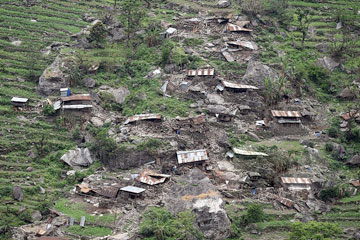Why Nepal response will be so hard
International aid is beginning to flow into earthquake-hit Nepal, but
much more is needed as the scale of the disaster becomes clear and the
list of challenges grows.
 |
|
Damaged houses in
Gorka,seen from an Indian Army helicopter
(Sajjad Hussein/AFP/Getty images)
|
“Three million of them are children, all affected within the space of
one day,” said Jean-Jacques Simon, chief of regional communications for
the UN Children’s Fund, UNICEF.
“There is an urgent need for temporary shelter in the 16 displacement
camps in the Kathmandu valley, and the many more around the region,”
said Simon. In hardest-hit areas, 50 percent of homes and buildings are
thought to have been destroyed. In the many camps that have been
established for those whose homes have collapsed or who are simply too
scared to return, clean water and better sanitation is a key concern.
Cholera is endemic in Nepal. Medical supplies and personnel are also
urgently required, International Medical Corps said in a statement over
the weekend.
“There are so many injured people, and not enough space, so people
are parked outside. People are also too afraid to be inside [the
hospitals] because of the tremors,” said Simon.
“From what I saw yesterday, there is clearly a lack of medicines, and
the morgue is very full,” he added.
Access, capacity and weather hamper aid effort
Poor communications are hampering the government and aid agency
efforts to assess the damage caused by the quake. Districts closest to
the epicentre - Gorkha, Makwanpur and Lamjung - are still proving almost
impossible to access. “Our teams are just going to the villages and
towns outside Kathmandu today. It’s a very difficult job. There are
landslide fears, and it’s drizzling now, so the weather is not helping,”
Devendra Singh Tak, Country Director of Save the Children India, told
IRIN. “But the government has given clear instructions to start
distributing. So the challenge for NGOs is to find solutions and get out
there,” Tak added.
Save the Children is struggling to find warehouse space for the surge
of aid that will be required. Kathmandu’s small international airport is
struggling to cope with the flow of relief supplies, aid workers and
journalists arriving and residents trying to escape. Prone to congestion
at the best of times, there are now major delays.
“There is complete chaos at the airport right now,” said Tak. “It’s
unable to cope with the scale of the problem.” Flying in from Delhi,
normally a 1.5-hour flight, took Tak 11 hours from departure lounge to
the arrival hall in Tribhuvan International Airport, including two hours
circling Kathmandu, waiting to land. Along with physical relief items,
more people are required to help ease the burden on local teams, said
Tak.n
“We at Save the Children have a large [local] team - but everyone has
a personal crisis to deal with first.”
(IRIN)
|

